All tarantulas are considered venomous. They have venom which is used when hunting prey. Their large size and hairy bodies can make people nervous, but they are considered relatively harmless to humans, except for a painful bite. Their venom is often weaker than a bee.
New World Tarantulas have bites that are of little threat to humans, only giving localized pain. Their urticating hairs, on the other hand, can cause skin irritation.
Old World Tarantulas, those indigenous to Asia, do not have the urticating hairs and will bite as a defense. The Old World Tarantula is more likely to bite if provoked.
Some species, such as the Poecilotheria species, can give a bite that may require hospitalization with pain, swelling, muscle cramping, fever, and exhaustion, which can last for days after the bite.
Certain species of Old World Tarantula are known for their strong venom, which can cause unpleasant muscle cramping. The Selenocosmia family and Phlogiellus family are toxic to canines and bites are known to cause a high fatality rate in domestic pets.
Table of Contents
The 13 Most Venomous Tarantulas
The thirteen most venomous tarantulas, from the least venomous to the most venomous, includes:
13. Hysterocrates gigas
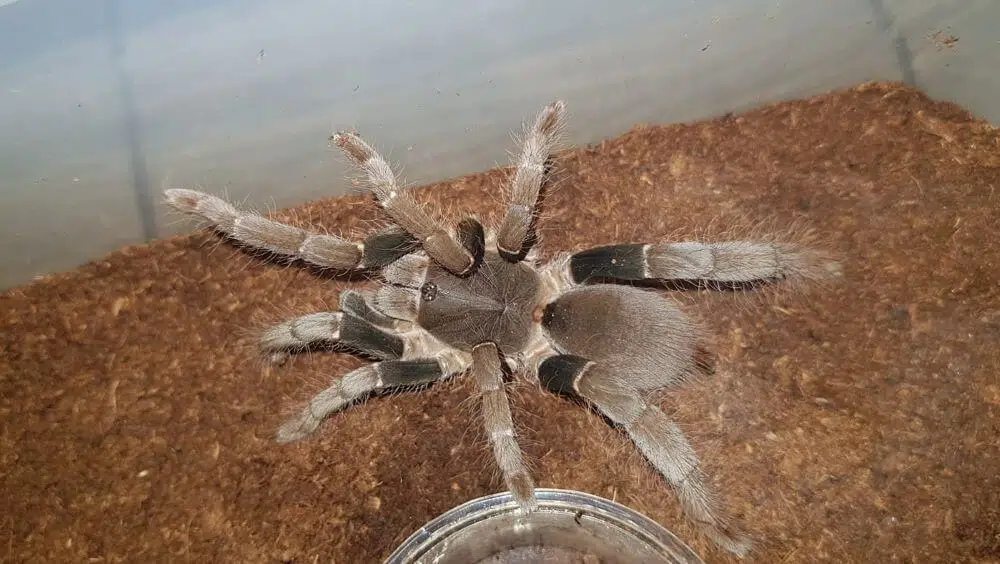
Scientific name: Hysterocrates gigas.
Common name: giant baboon spider, Cameroon red baboon spider, red baboon tarantula.
The Hystrocrates gigas is a tarantula found in Cameroon. It is also known as the red baboon tarantula, Cameroon red baboon spider, and giant baboon spider. This burrowing spider can range from gray to orange/brown and even dull black.
They are black when they have just molted and tend to turn brown just before their next molting. Their oval abdomens can reach up to 10cm in diameter. This Old World species does not have urticating hairs.
The leg span of the Hysterocrates gigas can be up to 20cm. They are found in subtropical and tropical climates. They are nocturnal hunters, eating what they can find.
While their venom is not considered medically significant, a bite can cause nausea or an allergic reaction, which may require medical attention.
12. Haplopelma Schmidti

Scientific name: Haplopelma Schmidti.
Common name: Chinese bird spider, Chinese earth tiger.
This spider belongs to the Theraphosidae family and is common in Vietnam and China. It is also known as a Chinese Earth Tiger and Chinese Bird Spider. This spider produces toxins, which are known as huwentoxins.
The Haplopelma Schmidti has a dark yellow to brown body with black stripes running across the abdomen and a black stripe down the center. Females are considered the largest of all the Asian spiders with a lifespan of up to thirty years.
These spiders are burrowing spiders that only leave their burrow at night to catch prey, which consists of large insects. These spiders will bite if provoked, which can cause pain in humans and severe symptoms in domestic pets.
11. Harpactirella lightfooti
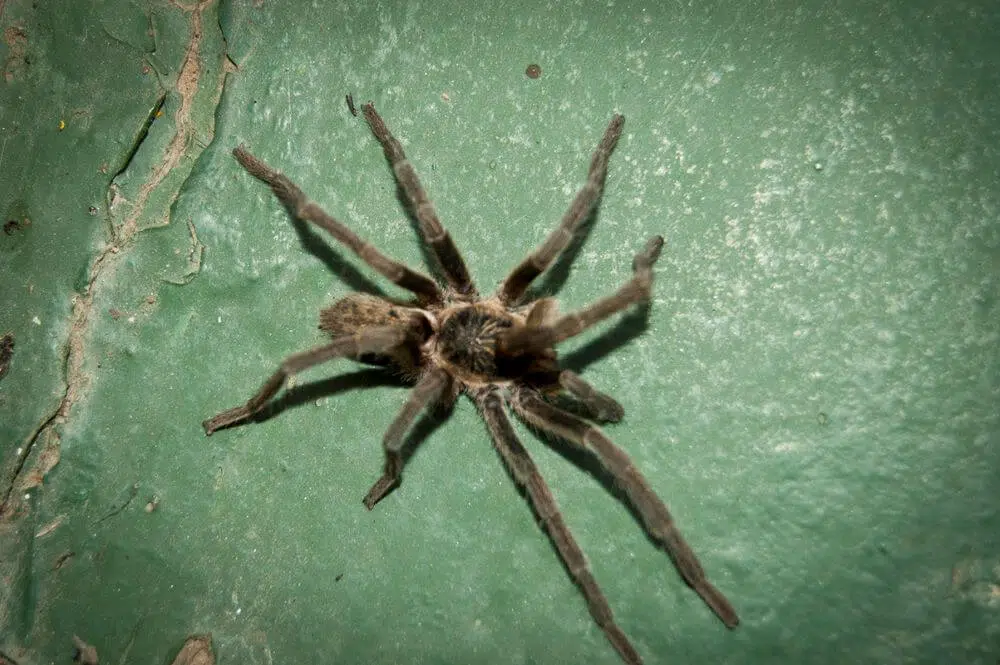
Scientific name: Harpactirella lightfooti.
Common name: Lesser baboon spiders.
The Harpactirella lightfooti is also known as the Lightfoot’s Lesser Baboon Spider and is a dwarf species, growing to 7cm. This Old World species has a fast growth rate and a nervous and skittish temperament. They come from the Cape Province in South Africa.
They are often encountered running across the floor at night, which are often males in search of a mate. Females grow larger than males, normally around 6cm. They are golden in color with stripes and spots on their abdomens in a fine bone pattern.
They create webs and use twigs, rocks, and other structures to build their shelters. If they cannot find a suitable structure, they will burrow. They are exceptionally fast and skittish. They bolt when you disturb them and will bite if they are provoked.
The Harpactirella lightfooti’s venom is potent and humans should try not to get bitten, as there are no conclusive tests on these bites in humans. The bite is painful and could cause muscle spasms and cramping.
10. Selenocosmia crassipes

Scientific name: Selenocosmia crassipes.
Common name: Queensland whistling tarantula, barking spider, whistling tarantula, hissing spider.
The Selenocosmia crassipes is also known as the barking spider or Queensland whistling tarantula, they are native to the Queensland east coast in Australia. They produce a hissing noise when provoked.
These tarantulas can grow to 22cm in leg span and a body length of up to 9cm. They are the largest Australian tarantula. Their venomous fangs can be 1cm in length.
The legs of this tarantula are thicker than the back legs. They are shy and seldom wander far from their burrow. Their bite is not fatal but can cause up to six hours of vomiting. Domestic pets, such as dogs and cats can die within thirty minutes of being bitten by one of these tarantulas.
9. Lampropelma nigerrimum
Scientific name: Lampropelma nigerrimum.
Common name: Sangihe black.
The Lamprropelma nigerrimum is a tarantula from Indonesia that can grow up to 18cm. These Old World tarantulas live mostly in trees. They have a fast growth rate and are fast and very defensive.
These tarantulas will bite if they are provoked. Bites can cause local pain, and swelling with muscle cramps, which are known to last for days. The cramping is usually localized to the bite site, so if you are bitten in the hand, your hand will cramp.
8. Pterinochilus murinus

Scientific name: Pterinochilus murinus.
Common name: orange baboon tarantula, Mombasa golden starburst tarantula.
This is an Old World tarantula that was first described in 1897. It is found in Africa from Southern Africa to Angola and is referred to as a baboon spider.
This is a very defensive species that will bite before it presents a threatening display. You should never try and hold one of these tarantulas. Their bite is not considered medically significant but can cause extreme pain.
Females grow to 15cm in leg span and males to 10cm. Their abdomen, legs, and carapace are usually the same color with their legs having brightly colored rings. There is a star-shaped pattern on the carapace and a fishbone pattern on the abdomen.
This species has five color variations, depending on where the spider is found. In Mozambique, they are brown, while those in Zimbabwe, Botswana, and Kenya are dark brown. In some areas, they are more orange.
Further Reading:
7. Cyriopagopus lividus

Scientific name: Cyriopagopus lividus.
Common name: cobalt blue tarantula.
The Cyriopagopus lividus, the Cobolt Blue Tarantula, can grow to 14cm as an adult. These Old World tarantulas are burrowing spiders with a fast growth rate. They are exceptionally defensive and you should not attempt to pick them up.
This species is native to Myanmar and just over the border in Thailand. They are medium in size with blue lights and light gray opisthosoma and prosoma. You cannot tell the male and female apart until their final molt, where males exhibit sexual dimorphism with light tan to bronze coloration.
These tarantulas spend the majority of their time in their burrows underground. A bite from this species can cause inflammation and severe muscle cramping.
Further Reading:
6. Pelinobius muticus

Scientific name: Pelinobius muticus.
Common name: King baboon spider.
This tarantula is better known as the King Baboon Spider and is found in Tanzania and Kenya in Africa. This east African tarantula is brown to orange in color and lives in the grasslands and shrublands, using vegetation to hide its burrows.
This tarantula uses stridulation as a defense mechanism. This is a shrill creaking sound, which it makes by rubbing their femurs on the first and second pair of legs together, the same as a cricket. The stridulation is done in conjunction with rearing up and striking.
King baboon spiders can grow to twenty centimeters and have thick back legs, which are used when digging their burrows. They hunt beetles, cockroaches, and other spiders.
This is a very defensive species that do not have urticating hairs but will not hesitate to bite. They have a strong venom and while they are not deadly to humans, their bites can cause pain and localized itching, which can last for up to five days.
5. Stromatopelma calceatum
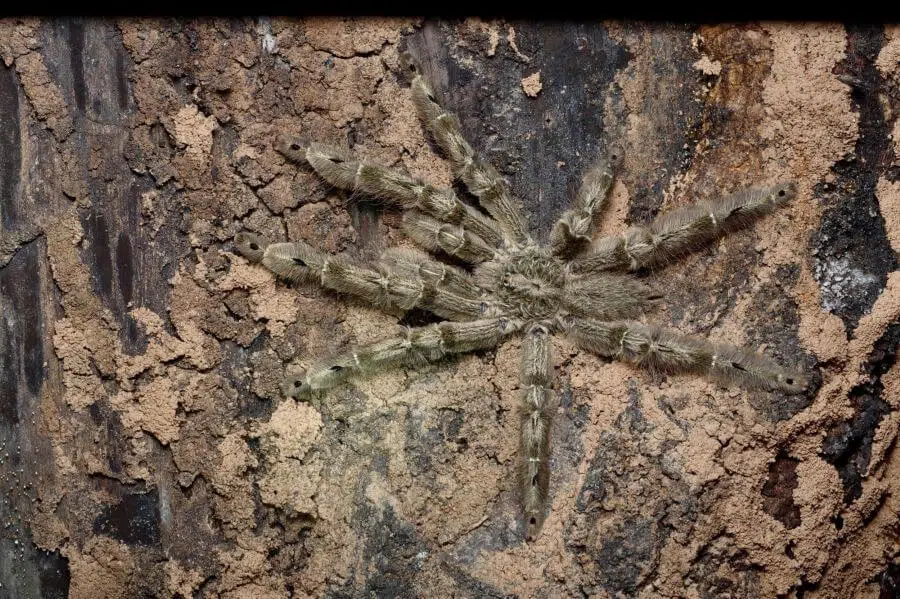
Scientific name: Stromatopelma calceatum.
Common name: Feather Leg Baboon Tarantula.
The Stromatopelma calceatum is an African tarantula, first described in 1881. They have a potent venom that induces medically significant effects. They are known as the Feather Leg Baboon Tarantula and grow to 16cm as an adult.
These are Old World tarantulas and prefer living in trees. They are exceptionally defensive and aggressive and should not be handled. These tarantulas don’t waste time when it comes to being defensive and will attack without hesitation.
They have strong venom and side effects are based on where you are bitten and how much venom the spider releases. It can cause extreme pain in the bite area, along with redness, inflammation, and muscle cramping.
4. Heteroscodra maculata
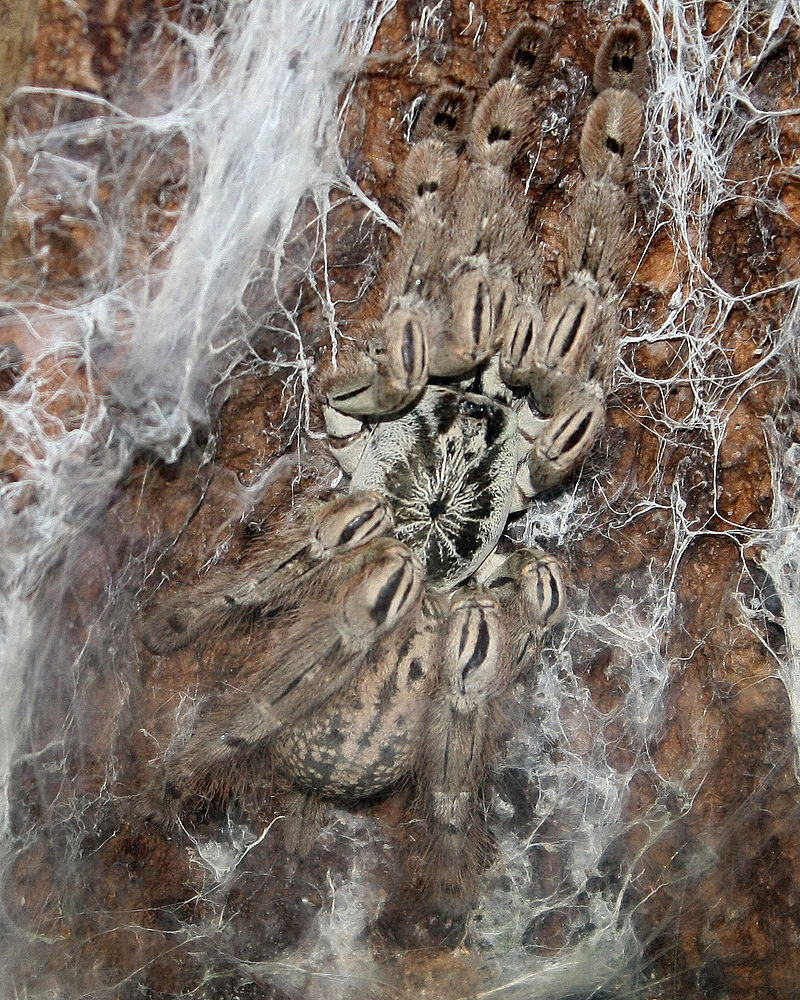
Scientific name: Heteroscodra maculata.
Common name: Togo starburst, ornamental baboon.
The Heteroscodra maculata, also known as the Togo Starburst, is a tarantula from West Africa that grows to 13cm in leg span. These are Old World, tree-dwelling tarantulas that are known for their defensive and aggressive behavior.
They are a chalky white color with black and brown mottled markings. This Old World species originates from Europe and Asia and has a potent venom. They are exceptionally fast, defensive, and have potent venom.
The Togo Starburst does not have urticating hairs, which is why they are quick to bite as their primary defense. Bites from this species cause pain and long-lasting muscle cramps.
3. Poecilotheria ornata
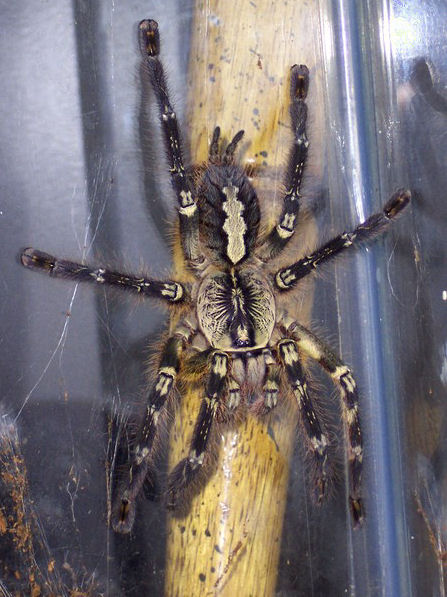
Scientific name: Poecilotheria ornata.
Common name: fringed ornamental, ornate tiger spider.
The Poecilotheria ornata is also known as the Fringed Ornamental Tarantula. This is a large tarantula growing to 25cm in leg span as an adult. They are Old World tarantulas and prefer living in trees.
This is considered the most dangerous tarantula and is known to bite faster than any other species in the tarantula family. They are highly aggressive and defensive. They originate from southern Sri Lanka and are lightning-fast from when they are slings through to adulthood.
This is a beautiful and large tarantula with potent venom. It will not hesitate to bite if provoked with bites causing intense pain, severe muscle cramping, and sometimes resulting in hospitalization.
2. Poecilotheria regalis

Scientific name: Poecilotheria regalis.
Common name: Indian ornamental tree spider, Indian ornamental.
Poecilotheria regalis is a tree tarantula that is common in India. They are often called the Indian ornamental tree spider and can grow to 18cm in leg span.
These spiders live in the holes of trees, where they create funnel webs. Their diet comprises flying insects, which they capture in flight and paralyze with their venom.
The Poecilotheria regalis is known as a defensive spider. There have been no human deaths resulting from a bite from this tarantula, but their bites are considered medically significant. A bite can cause intense pain, while their large fangs can cause a secondary bacterial infection if not treated properly.
1. Poecilotheria metallica

Scientific name: Poecilotheria metallica.
Common name: Gooty sapphire ornamental.
Poecilotheria metallica is also known as the peacock tarantula and an Old World species. They originate in central-southern India and are classified as Critically Endangered by the IUCN.
This species is covered in blue hair. Males are slender with longer legs when compared to females. These tarantulas can grow to a 20cm leg span as adults.
A bite from this tarantula is considered medically significant, even though there are no recorded human deaths as a result of a bite. The venom is known to cause extreme pain, increased heart rate, sweating, headache, cramping, stinging, and swelling. These side effects can last up to a week.
Extreme bites can still be felt months later. The good news is that this tarantula does give what are known as “dry bites” most of the time, where no venom is injected.
The Most Venomous Spider
The Brazilian wandering spider (Phoneutria fera) is the most aggressive and venomous spider, which was first discovered in Brazil. It can be found in Brazil, Southern, and Central America.
This spider was recorded in the Guinness Book of World Records in 2007 for being the most venomous animal in the world. The title is also given to the Sydney funnel-web spider (Atrax robustus).
They grow to around 13cm in leg span as adults and are large and hairy spiders.
These fast-moving spiders have red jaws and strong legs. They wander the jungle floor using the dense vegetation to take cover and hide during the day. They are known to hide in clothes, homes, boxes, log piles, and homes.
Many people refer to this spider as the banana spider. It is not uncommon to find these large spiders in banana shipments. A bite from this spider can cause a small pinprick to serious complications.
Anyone bitten by a Brazilian wandering spider will want to seek immediate emergency treatment, as this venom could be life-threatening. Their bites are excruciatingly painful.
Further Reading: